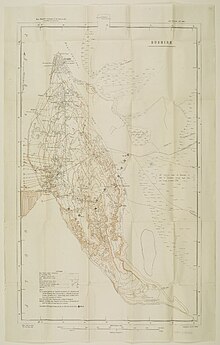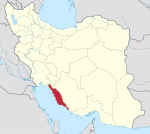Bushehr
Bushehr
Persian: بوشهر | |
|---|---|
City | |
Panoramic, Clock tower at night, Malek Palace, Amiriya Mansion, Saadat school | |
 | |
| Coordinates: 28°55′35″N 50°51′05″E / 28.92639°N 50.85139°E[1] | |
| Country | Iran |
| Province | Bushehr |
| County | Bushehr |
| District | Central |
| Government | |
| • Mayor | Hossein Heydari |
| Elevation | 18 m (59 ft) |
| Population (2016)[2] | |
| • City | 223,504 |
| • Metro | 398,581 |
| Time zone | UTC+3:30 (IRST) |
| Climate | BSh |
| Website | www www |
Bushehr (Persian: بوشهر; [buːˈʃe(h)ɾ] )[a] is a port city in the Central District of Bushehr County, Bushehr province, Iran, serving as capital of the province, the county, and the district.[4]
Etymology
[edit]The roots of the name "Bushehr" are uncertain. It is unlikely that it is derived from Abū Šahr ("father of the city"), a theory which remains popular. It may be an abbreviation of Bokht-Ardashir ("Ardashir has given"), though this is not backed by conclusive evidence.[5][6] [1].
History
[edit]Origins
[edit]A number of alleged premodern references to Bushehr, including the first made by an Arab geographer in 1225, have been disputed as perhaps alluding to the modern city of Reishahr, a harbor 10 km to the south, where archaeological evidence points to the presence of a much older settlement.[5] Reishahr is also most likely equivalent to the town of Mesambria, a place the Greeks knew since the campaign of Nearchus (died 300 BC), and which also has been occasionally identified with Bushehr.[6]
Rise
[edit]In 1734, the Iranian military commander Nader made Bushehr (then still a minor fishing village) the headquarters of the Persian Gulf fleet that he sought to create.[6][5] This marked the start of Bushehr's rising importance. In order to build a massive warship, Nader even brought heavy wood from Mazandaran's forests, which was 1,000 km away from Bushehr. The shell of this ship drew notice from European travelers for the next 50 years. The naval aspirations of Nader ended when he was murdered in 1747, but Bushehr continued to serve as a prominent port for at least the following 150 years. Between 1737–1753, the Dutch East India Company ran a trading facility there.[5]
Aside from Bushehr's strategic significance—being situated 300 km from Shiraz and 600 km from that of Ottoman-ruled Basra—the place offered few benefits and numerous drawbacks. The town and its surrounding area were somewhat shielded by the interior's hilly terrain and narrow gorges, but were still vulnerable to pirate intrusion. In the 19th century, European ships had to dock around four kilometers offshore and transfer freight and passengers through small boats due to the shallow path to both the shoreline and the bay. Despite the numerous windcatchers on top of the houses, the water in the wells was salty, and the summer heat and humidity were unbearable.[5]
The main commercial port of Iran
[edit]Bushehr soon replaced Bandar Abbas as the country's most important commercial port. This was because of Iran's political and economic centre being moved to Shiraz under the Zand ruler Karim Khan Zand (r. 1751–1779), who had established his authority in western Iran.[5][6]

Demographics
[edit]Language
[edit]Linguistic composition of the city.[7]
Population
[edit]At the time of the 2006 National Census, the city's population was 161,674 people in 25,158 households.[8] The census in 2011 counted 195,222 people in 52,204 households.[9] The 2016 census measured the population of the city as 223,504 people in 63,820 households.[2]
Climate
[edit]Bushehr has a hot semi-arid climate (Köppen: BSh) with a precipitation pattern resembling a Mediterranean climate, albeit it is both too hot and dry for too long to qualify as such, by a wide margin, due to the threshold for hot climates being much higher in terms of required rainfall.
| Climate data for Bushehr (1951–2010) | |||||||||||||
|---|---|---|---|---|---|---|---|---|---|---|---|---|---|
| Month | Jan | Feb | Mar | Apr | May | Jun | Jul | Aug | Sep | Oct | Nov | Dec | Year |
| Record high °C (°F) | 30.0 (86.0) |
32.0 (89.6) |
38.0 (100.4) |
42.5 (108.5) |
47.0 (116.6) |
48.6 (119.5) |
50.0 (122.0) |
47.0 (116.6) |
46.0 (114.8) |
41.0 (105.8) |
34.5 (94.1) |
32.0 (89.6) |
50.0 (122.0) |
| Mean daily maximum °C (°F) | 18.6 (65.5) |
20.2 (68.4) |
24.2 (75.6) |
29.6 (85.3) |
34.5 (94.1) |
36.4 (97.5) |
37.8 (100.0) |
38.1 (100.6) |
36.6 (97.9) |
32.9 (91.2) |
26.6 (79.9) |
21.0 (69.8) |
29.7 (85.5) |
| Daily mean °C (°F) | 14.5 (58.1) |
15.8 (60.4) |
19.3 (66.7) |
24.3 (75.7) |
29.0 (84.2) |
31.4 (88.5) |
33.1 (91.6) |
33.3 (91.9) |
30.8 (87.4) |
26.9 (80.4) |
21.3 (70.3) |
16.5 (61.7) |
24.7 (76.5) |
| Mean daily minimum °C (°F) | 10.3 (50.5) |
11.4 (52.5) |
14.4 (57.9) |
18.9 (66.0) |
23.6 (74.5) |
26.3 (79.3) |
28.4 (83.1) |
28.4 (83.1) |
25.1 (77.2) |
20.9 (69.6) |
16.0 (60.8) |
12.0 (53.6) |
19.6 (67.3) |
| Record low °C (°F) | −1.0 (30.2) |
2.5 (36.5) |
5.0 (41.0) |
8.0 (46.4) |
14.0 (57.2) |
18.0 (64.4) |
21.0 (69.8) |
22.0 (71.6) |
17.0 (62.6) |
12.0 (53.6) |
5.0 (41.0) |
2.0 (35.6) |
−1.0 (30.2) |
| Average precipitation mm (inches) | 78.5 (3.09) |
31.8 (1.25) |
22.4 (0.88) |
8.6 (0.34) |
2.6 (0.10) |
0.0 (0.0) |
0.0 (0.0) |
0.3 (0.01) |
0.0 (0.0) |
5.7 (0.22) |
39.4 (1.55) |
78.7 (3.10) |
268.0 (10.55) |
| Average precipitation days (≥ 1.0 mm) | 5.9 | 3.4 | 3.1 | 1.7 | 0.4 | 0.0 | 0.0 | 0.0 | 0.0 | 0.5 | 2.7 | 5.3 | 22.0 |
| Average relative humidity (%) | 75 | 72 | 66 | 60 | 56 | 58 | 61 | 65 | 65 | 66 | 66 | 73 | 65 |
| Mean monthly sunshine hours | 199.1 | 195.4 | 217.4 | 232.0 | 292.5 | 329.7 | 314.0 | 320.9 | 293.8 | 279.0 | 227.3 | 193.5 | 3,094.6 |
| Source: Iran Meteorological Organization (records),[10] (temperatures),[11] (precipitation),[12] (humidity),[13] (days with precipitation),[14] (sunshine)[15] | |||||||||||||
Nuclear development
[edit]Bushehr is twelve kilometres from the site of the Bushehr Nuclear Power Plant being built in cooperation with Russia. The work was begun by the Bonn firm Kraftwerk Union A.G., a unit of Siemens AG, which contracted to build two nuclear reactors based on a contract worth $4 to $6 billion, signed in 1975.
Work stopped in January 1979, and Kraftwerk Union fully withdrew from the project in July 1979, with one reactor 50% complete, and the other reactor 85% complete. They said they based their action on Iran's non-payment of $450 million in overdue payments. The company had received $2.5 billion of the total contract. Their cancellation came following the 1979 Iranian Revolution. Iran subsequently requested that Siemens finish construction, but Siemens declined. Shortly afterward Iraq invaded Iran and the nuclear programme was stopped until the end of the war. The reactors were damaged by multiple Iraqi airstrikes between March 1984 and 1988.[16]
In 1995, Russia signed a contract to supply a light water reactor for the plant (the contract is believed to be valued between $700 million and $1.2 billion USD). The agreement calls for the spent fuel rods to be sent back to Russia for reprocessing. The plant started adding electricity to the national grid on 3 September 2011,[17] and was officially opened in a ceremony on 12 September 2011.[citation needed]
See also
[edit]![]() Media related to Bushehr at Wikimedia Commons
Media related to Bushehr at Wikimedia Commons
![]() Bushehr travel guide from Wikivoyage
Bushehr travel guide from Wikivoyage
Notes
[edit]References
[edit]- ^ OpenStreetMap contributors (25 August 2024). "Bushehr, Bushehr County" (Map). openstreetmap.org (OpenStreetMap) (in Persian). Retrieved 25 August 2024.
- ^ a b Census of the Islamic Republic of Iran, 1395 (2016): Bushehr Province. amar.org.ir (Report) (in Persian). The Statistical Center of Iran. Archived from the original (Excel) on 3 August 2017. Retrieved 19 December 2022.
- ^ Bushehr can be found at GEOnet Names Server, at this link, by opening the Advanced Search box, entering "-3057164" in the "Unique Feature Id" form, and clicking on "Search Database".
- ^ Habibi, Hassan (c. 2024) [Approved 21 June 1369]. Approval of the organization and chain of citizenship of elements and units of the national divisions of Bushehr province centered on Bushehr city. lamtakam.com (Report) (in Persian). Ministry of the Interior, Political Defense Commission of the Government Board. Notification 82824/T138K. Archived from the original on 24 April 2024. Retrieved 24 April 2024 – via Lam ta Kam.
- ^ a b c d e f Perry 2017.
- ^ a b c d de Planhol 1990.
- ^ "Language distribution: Bushehr Province". Iran Atlas. 2015. Retrieved 31 January 2023.
- ^ Census of the Islamic Republic of Iran, 1385 (2006): Bushehr Province. amar.org.ir (Report) (in Persian). The Statistical Center of Iran. Archived from the original (Excel) on 20 September 2011. Retrieved 25 September 2022.
- ^ Census of the Islamic Republic of Iran, 1390 (2011): Bushehr Province. irandataportal.syr.edu (Report) (in Persian). The Statistical Center of Iran. Archived from the original (Excel) on 3 April 2023. Retrieved 19 December 2022 – via Iran Data Portal, Syracuse University.
- ^ *"Highest record temperature in Bushehr by Month 1951–2010". Iran Meteorological Organization. Archived from the original on 5 October 2018. Retrieved 8 April 2015.
- "Lowest record temperature in Bushehr by Month 1951–2010". Iran Meteorological Organization. Archived from the original on 5 October 2018. Retrieved 8 April 2015.
- ^ *"Average Maximum temperature in Bushehr by Month 1951–2010". Iran Meteorological Organization. Archived from the original on 6 March 2016. Retrieved 8 April 2015.
- "Average Mean Daily temperature in Bushehr by Month 1951–2010". Iran Meteorological Organization. Archived from the original on 27 April 2018. Retrieved 8 April 2015.
- "Average Minimum temperature in Bushehr by Month 1951–2010". Iran Meteorological Organization. Archived from the original on 6 March 2016. Retrieved 8 April 2015.
- ^ "Monthly Total Precipitation in Bushehr by Month 1951–2010". Iran Meteorological Organization. Archived from the original on 16 May 2018. Retrieved 8 April 2015.
- ^ "Average relative humidity in Bushehr by Month 1951–2010". Iran Meteorological Organization. Archived from the original on 6 March 2016. Retrieved 8 April 2015.
- ^ "No. Of days with precipitation equal to or greater than 1 mm in Bushehr by Month 1951–2010". Iran Meteorological Organization. Archived from the original on 6 March 2016. Retrieved 8 April 2015.
- ^ "Monthly total sunshine hours in Bushehr by Month 1951–2010". Iran Meteorological Organization. Archived from the original on 6 March 2016. Retrieved 8 April 2015.
- ^ Pike, John. "Bushehr - Iran Nuclear Reactor". www.globalsecurity.org.
- ^ "Iranian nuclear power station 'begins generating electricity'". The Guardian. London. Reuters. 4 September 2011. Retrieved 4 September 2011.
Sources
[edit]- Perry, John R. (2017). "Bushire". In Fleet, Kate; Krämer, Gudrun; Matringe, Denis; Nawas, John; Rowson, Everett (eds.). Encyclopaedia of Islam (3rd ed.). Brill Online. ISSN 1873-9830.
- de Planhol, Xavier (1990). "Būšehr i. The City". Encyclopaedia Iranica.









